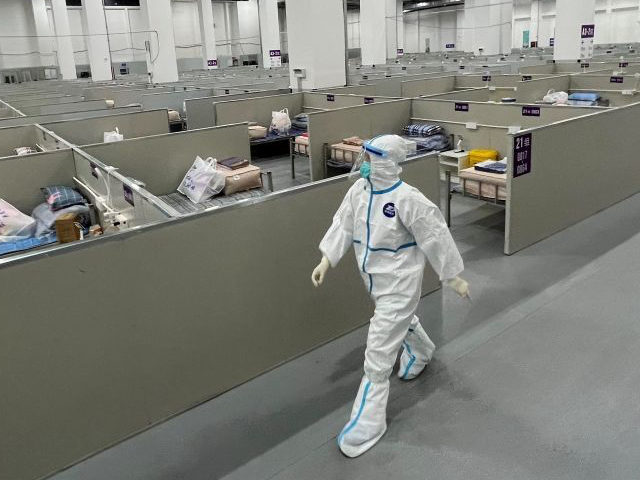Beijing’s government on Sunday reopened a makeshift hospital — previously used to treat Chinese coronavirus patients in early 2020 — to quarantine at least 12 Chinese coronavirus patients as part of the city’s effort to contain its latest outbreak of the disease, the state-run Global Times reported.
“The Xiaotangshan makeshift hospital, once used for accommodating SARS patients in 2003 and also used for treating local COVID-19 [Chinese coronavirus] patients in early 2020, consists of nine isolation units and 1200 beds,” the newspaper noted on May 1.
“At present, the first isolation unit has been activated, and a total of 40 medical workers, including eight doctors, 30 nurses and two epidemic control specialists, have been deployed to the isolation unit, with 12 asymptomatic patients and mild cases already transferred to the facility,” Li Ang, the deputy director of Beijing’s Municipal Health Commission, told reporters at a press conference on Sunday.
“Moving forward, the hospital will use the remaining isolation units according to the development of the epidemic situation, and select medical staff from 19 municipal hospitals to assist with treatment in the hospital,” Li said.
News that Beijing’s government — which is directly administered by China’s ruling Communist Party — reopened a quarantine facility on May 1, previously used to treat patients during prior epidemics, followed shortly after the Global Times on April 30 reported that the metropolis was preparing to both reopen and construct new medical clinics across Beijing to combat its most recent Chinese coronavirus outbreak.
“The city now has already built and converted more venues into makeshift hospitals to meet the potential quarantine caseload caused by the current situation,” the publication quoted an unnamed Beijing government official as saying on April 30.
“Beijing has already built makeshift hospitals with a capacity of 4,000 beds, and at the same time is also converting some large scale venues into makeshift hospitals, while several districts are also conducting work to select potential makeshift hospital sites,” Li Ang, a spokesperson for Beijing’s epidemic control center, told reporters at a press briefing on Saturday.
Beijing’s latest outbreak of the Chinese coronavirus began around April 22. Municipal health officials documented 350 Chinese coronavirus cases across 14 districts of Beijing from April 22 to May 1, according to the Global Times. Beijing is China’s national capital and has an estimated population of 21.3 million.
Beijing’s latest Chinese coronavirus outbreak is directly tied to a nationwide resurgence of the disease that has swept through China’s most densely populated cities in recent months, most notably in Shanghai. A total lockdown of Shanghai’s 25 million-plus residents began on April 5 and remained in place at press time on May 2. The financial hub began a mass testing scheme for the Chinese coronavirus on March 28 that soon evolved into a city-wide lockdown of the metropolis.
Beijing’s government has followed Shanghai’s anti-epidemic example, first ordering millions of Beijing residents to undergo Chinese coronavirus testing starting April 25 before issuing lockdown edicts for several of Beijing’s residential districts on April 29.

COMMENTS
Please let us know if you're having issues with commenting.